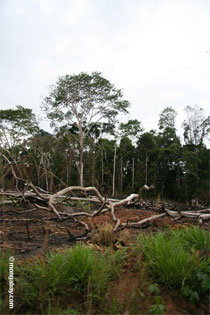Scent-tagging wood could cut illegal timber smuggling
mongabay.com
January 5, 2006
In the future illegally harvested timber could be tracked by their scent according to researchers at Oregon State University.
The wood-sniffing device would allow the timber industry to certify that individual products come from sustainably harvested operations and cut down on illegal logging. Such a device could prove cost-effective for the timber industry and governments of timber-exporting countries. According to World Bank estimates, governments lose about US$5 billion in revenues annually as a result of illegal logging while overall losses to the national economies of timber producing countries add up to an additional US$10 billion per year.
A news release from Oregon State University appears below.
Log ‘Smelling’ Might Aid Forest Products Industry
December 22, 2006
By David Stauth
Oregon State University
CORVALLIS, Ore. – In the continuing effort to add value to forestry operations and improve efficiency, one of the latest ideas is to use “aroma tagging” of logs to track their movement from the forest to the mill and possibly even the finished product – a feat that might make a bloodhound envious.
Forestry researchers at Oregon State University have done some of the earliest work in this emerging field of study and outlined the challenges, which are many.
But with improved technology scientists may be able to apply various scents to trees and effectively track the movement of wood, in a competitive industry where every bit of information can add to a product’s value.
Around the world, 5 billion logs a year are harvested and moved. They are not easy to track.
“We’re trying to create a ‘wood hound,’ something that can track a tree by its smell,” said Glen Murphy, a professor of forest engineering in the OSU College of Forestry. “It’s hard to tell where all this may lead, but it’s clear there would be ways to use this technology.”
If you could track a log through the maze of the timber production system, Murphy said, there might be key advantages in marketing – the certification of “green” forest products, for instance, requires careful chain-of-custody monitoring. Measurements of a log made in the field could find immediate application in the timber mill, increasing production efficiency. If the wood quality from a certain area or type of forest stand was desirable, operators would be able to track where the wood came from and what forest management techniques were used to produce it.

|
And such technology might be very useful in preventing timber theft, experts say, along with the lost government taxes and revenues associated with it.
“At the moment, we have ways of tracking logs that are only partially effective,” Murphy said. “Bar coding is awkward and leaves plastic tags or metal staples that can cause problems in mills. Radio frequency identification tags are very expensive; with some pulp logs they might cost more than the product you are selling. So we need improved technologies.”
Aroma tagging, Murphy said, is already being used in the marketplace – some manufacturers have used it to help prevent brand piracy. The food industry uses electronic nose systems to measure freshness, the medical profession to detect disease, natural gas companies to detect leaks and in law enforcement to identify drugs or explosives.
The days when only a trained dog had the smell capability to track something are long past.
The technology uses an instrument that can detect specific chemical scents – with about 25 chemical scents in various combinations you could track more than 33 million logs, Murphy said. The spray-on technology is already available, but improvements need to be made in the chemicals and electronic nose used for this concept, which are based on sophisticated sensing and pattern recognition systems.
The ideal chemical tag would have to withstand harsh climatic conditions, be dragged over dirty ground, sit for weeks in the hold of a ship, or undergo processing with heat or preservatives.
“I think the right chemicals could deal with the issues of time, weather, and other wood treatments,” Murphy said. “You need something you can apply that will still be detectable through the processing of the wood. Conceptually, this is a little like the unique code found in every animal’s DNA, except it’s something you can smell.”
The technology of using aroma tagging only goes back about 10 years, Murphy said, and is still in its infancy in the timber industry. Work is needed to identify the most appropriate chemicals for tagging, develop better scent detection systems, and perfect other technologies. Additional funding is needed to move the technology into commercial use, he said.
This is a modified news release from the Oregon State University